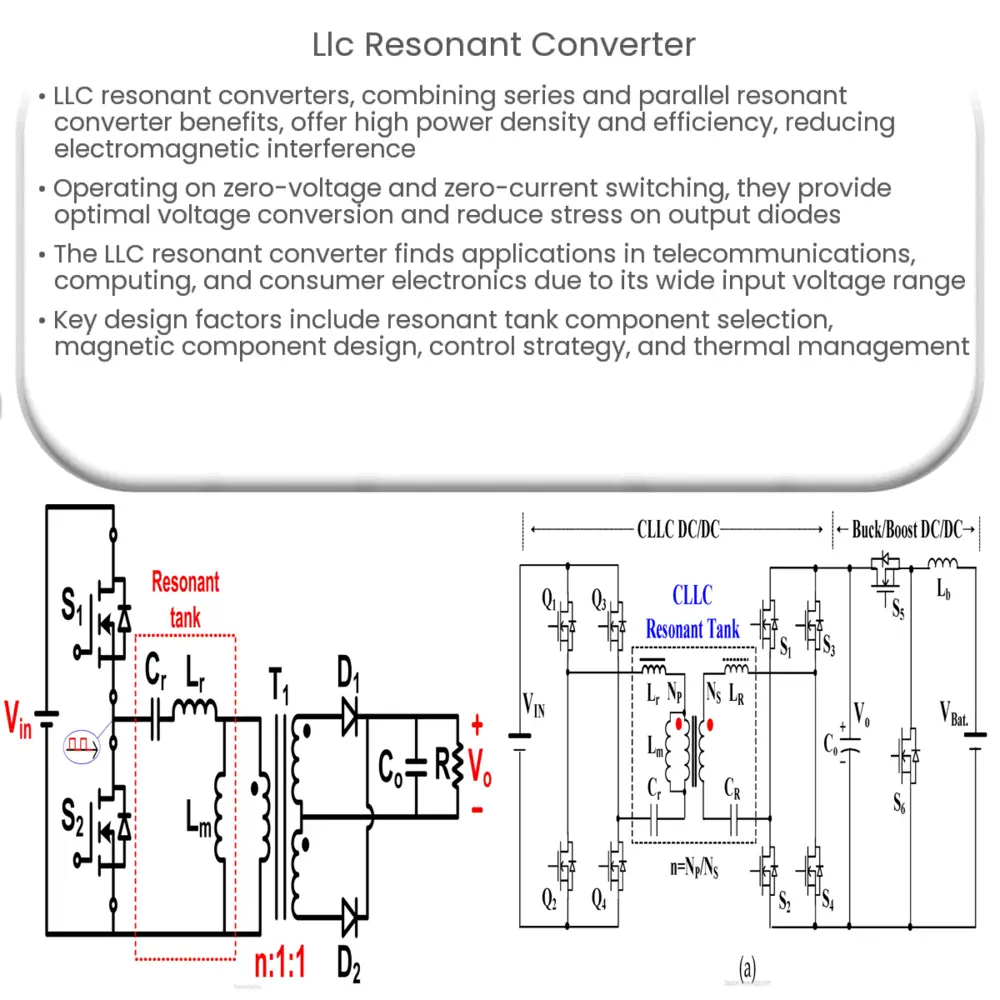The LLC resonant converter is an efficient power conversion topology, offering high efficiency, wide input voltage range, reduced EMI, and high power density for various applications.

LLC Resonant Converter: An Overview and Applications
The LLC resonant converter has emerged as a popular and efficient power conversion topology for a wide range of applications. This converter topology combines the benefits of a series resonant converter (SRC) and a parallel resonant converter (PRC), offering improved efficiency, high power density, and reduced electromagnetic interference (EMI). In this article, we will delve into the basics of LLC resonant converters, their working principle, and their real-world applications.
Understanding the LLC Resonant Converter
An LLC resonant converter is a type of resonant power converter that utilizes an inductor-inductor-capacitor (LLC) resonant tank circuit. This resonant tank comprises two inductors (Lm and Lr) and a capacitor (Cr). The primary inductor Lm is magnetically coupled to the secondary inductor Lr through a transformer, while the capacitor Cr is connected in parallel with the secondary inductor.
LLC resonant converters are typically used for applications requiring high efficiency, wide input voltage range, and high power density. They can be employed in a variety of industries, including telecommunications, computing, and consumer electronics.
Operating Principle
The LLC resonant converter operates based on the concept of zero-voltage switching (ZVS) and zero-current switching (ZCS). These switching techniques help minimize switching losses and improve efficiency. The ZVS technique ensures that the voltage across the switching devices is zero when they are turned on, whereas the ZCS technique ensures that the current flowing through the switching devices is zero when they are turned off.
When the switching frequency of the converter is above the resonant frequency of the LLC tank, the converter operates in the ZVS mode, providing an efficient voltage conversion. When the switching frequency is below the resonant frequency, the converter operates in the ZCS mode, which reduces the stress on the output diodes and enhances the overall efficiency.
The control method of an LLC resonant converter typically involves adjusting the switching frequency to regulate the output voltage. This approach maintains a high efficiency over a wide range of input voltages and load conditions.
Key Advantages
- High Efficiency: Due to ZVS and ZCS, the LLC resonant converter exhibits low switching losses and high efficiency.
- Wide Input Voltage Range: The frequency control approach allows for efficient operation over a wide range of input voltages.
- Reduced EMI: The soft switching techniques employed by the LLC converter result in reduced EMI, making it suitable for applications with strict EMI requirements.
- High Power Density: Owing to its high efficiency and reduced component count, the LLC resonant converter offers high power density, making it ideal for compact power supply designs.
Design Considerations
Designing an efficient and reliable LLC resonant converter involves several considerations. Some key factors to take into account during the design process include:
- Resonant Tank Component Selection: Choosing appropriate values for the inductors and capacitor in the resonant tank is crucial for optimal performance. Designers must consider the desired resonant frequency, power level, and efficiency targets when selecting these components.
- Magnetic Component Design: The transformer used in the LLC resonant converter must be designed to handle the power requirements and maintain proper magnetic coupling between primary and secondary inductors. Ensuring proper core selection, winding techniques, and insulation materials are vital for achieving the desired performance.
- Control Strategy: Implementing a robust control strategy is essential to maintain output voltage regulation and overall system stability. Various control methods can be employed, such as analog or digital control techniques, depending on the specific application requirements.
- Thermal Management: Proper thermal management is necessary to ensure the converter’s reliability and longevity. Designers must consider the heat dissipation requirements and select appropriate cooling methods, such as heatsinks or fans, based on the converter’s power rating and operating environment.
Applications of LLC Resonant Converters
LLC resonant converters are widely used in various industries due to their high efficiency, wide input voltage range, and high power density. Some common applications include:
- Telecommunication Power Supplies: The high efficiency and compact form factor of LLC resonant converters make them ideal for powering telecom equipment, such as base stations, routers, and switches.
- Server Power Supplies: Data centers and server farms require efficient and reliable power supplies. LLC resonant converters can provide high power density and excellent efficiency, minimizing energy consumption and reducing operational costs.
- Electric Vehicle (EV) Chargers: Fast charging of electric vehicles demands high power and efficiency. LLC resonant converters can be employed in EV chargers to provide efficient power conversion and help reduce charging times.
- Consumer Electronics: LLC resonant converters can be found in various consumer electronics devices, such as LED TVs, gaming consoles, and desktop computers, where high efficiency and compact design are essential.
- Industrial Power Supplies: Industrial applications often require rugged and reliable power supplies. The LLC resonant converter’s inherent efficiency and soft-switching capabilities make it a suitable choice for such demanding environments.
In conclusion, the LLC resonant converter has proven to be a versatile and efficient power conversion topology, finding applications in numerous industries. Its combination of high efficiency, wide input voltage range, reduced EMI, and high power density makes it an attractive choice for designers and engineers in the quest for optimal power supply solutions.

